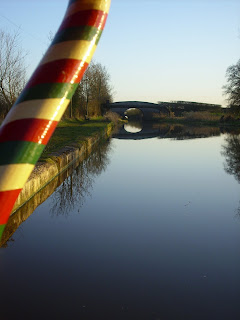










nb Hurcules
We encountered feverish activity in the cutting before Bridge 6, with both BW and the Shropshire Union Canal Society hard at work. BW were trimming back the undergrowth and using a wood chipper to fire the trimmings into nb Hercules. Sadly the chipper was angled wrongly and more chips were being blown into the canal than the hold! I suppose it makes unloading easier... Meanwhile the canal society, on a small flotilla of narrowboats were busy building a lovely picnic area complete with tables and chairs on concrete plinths. They were doing a great job, as they have done up and down the whole Shroppie over the years.
Church Minsull sports the brand new "Aqueduct marina, all bare and new, but surprisingly full of boats.

Lion Saltworks
The rather smart ground of Northwich Victoria lies next to the canal, its prosperity probably more a testament to it also being the home ground of Manchester United Reserves than the skill of the team which bears the name of the nearby town. We parted company with Away4aWhile at the ABC base, recovering the tea mug and promising to meet up again in Birmingham.


Tyrley Locks



The Shroppie Fly PH
Just above Audlem Bottom Lock we passed nb Debdale. Sadly the current crew of this shared ownership craft were not the editors of the Debdale Blog but awarded me 10:10 for observation.
As we exited the second Hack Green Lock we caught our first sight of our destination - the Pennines, three days cruising away in the north east.



 nb Starcross
nb Starcross

No. in fact I was paying homage to the new love of my life - a 120 gigabite i-pod classic. Until recently I viewed i-pods as an affectation beloved of adolescents and poseurs, but I am a convert. When I worked in the Venture Capital Industry the rule of thumb was that for an innovation to be really successful it has to be five times better than its predecessor. How this multiple was measured was open to debate, but the i-pod certainly fits the criteria.
If I could take one item back into my past to show and impress my teenage self it would be the seemingly humble i-pod. A machine no larger than a calculator that can store my entire extensive music collection, and then twice as much again! Absolutely mind blowing and such a far cry from my treasured box of 15 favourite cassette tapes. They were even called compact as I recall!
Having succumbed to Apple's techno wonder, I find myself wanting to use it wherever I go. The car was a problem initially because being old (4 years!) the stereo doesn't have an i-pod plug. This was overcome by one of those radio widgets which transmit a signal that can be picked up by the radio, and powered by the cigarette lighter. But what of the boat? I can't go away for two weeks without a way to access my favourite tunes - or even worse - a power source to re-charge the object of my infatuation.
Aint she cute!
This brings me back to my visit to Halfords. I figured that if my radio thingey can work in the car, then why not on the boat radio / CD? The problem was a lack of power, or rather the fact that I built a 12v power supply in the wrong place and only included one. These boy racers know a thing or two about power supplies for all their bolt on accessories, so if you can't beat them why not join them?
I am now the proud owner of a 12 volt power supply splitter which plugs into the inaccessible socket and delivers three sources of yummy 12v, all backlit by a lurid pulsating blue light. Very hip, very trendy, very boat boy bling!
Whatever next? Perhaps a spoiler on the back, furry dice in the front and some spinners down the sides? Who knows!

Following on from my earlier blog about BW’s plans to build 25 small scale hydro electric plants, a bit more detail has emerged about their power play to become a force in electricial generation.
Sorry about the truly terrible puns, but the subject matter is such fertile ground.
We are told that the first five plants will be built on existing weirs on the Severn and the
Clearly these major rivers hold potential for many generation stations, so I guess that these are pilots to see how they perform throughout the seasons. BW also point out that they own about 90 feeder streams which deliver running water to the canals and that many of these have electrical generation potential. Or is that Kinetic… I think Kinetic is the latent power within an already moving object whereas potential is merely something that has, well you know, the potential to be turned into energy…. Or maybe it’s the other way round.
These schemes are going to cost £120m of which £20m has already been pledged by Climate Change Capital. However, they will have to get their skates on if they are to hit their objective of 40 megawatts flowing into the National Grid by 2010.
I am all for schemes like this, which increase our sustainable energy production and opens up a new source of income for cash strapped British waterways. So, if you are travelling these rivers over the next year or so keep you eyes peeled.
It sounds as if BW are entering a powerplay from which there can be no losers.

















